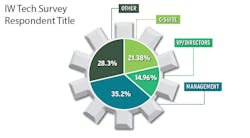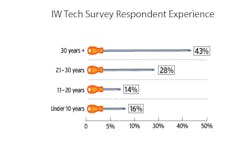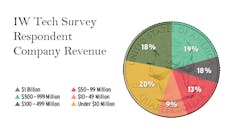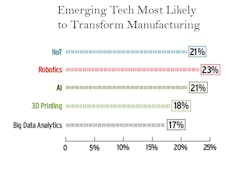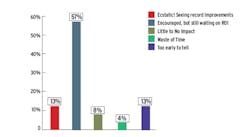Diving Deep into Emerging Tech Reveals Scary Truths
If you follow technology news at all, you’ve probably noticed something strikingly similar about all the breaking advancements in artificial intelligence, robotics and Industry 4.0. It’s not as much as what they do or how they work, but how they are marketed.
Each emerging technological wonder promises the same type of dramatic fat-trimming reductions and productivity growth as the products plastering late night weight loss or hair-gaining infomercials. Lose 20% downtime in no time! Boost your business confidence in a big way with Big Data analytics!
Sometimes this puts me precariously close to becoming an unwitting pitchman, because I write about this stuff every day, highlighting the amazing improvements AI or analytics can provide—such as GE’s Predix platform making equipment 18% more effective at its Indian Brilliant Factory.
That’s great stuff and an indicator of where industry is going someday, but it’s not representative of the usual U.S. manufacturing experience of today. GE’s a gigantic multinational conglomerate, with 106,000 employees as of last year—and was founded by Thomas Edison. A vast majority of the rest are, comparatively speaking, boutique shops owned and operated by regular folks.
And by regular, that’s not meant to impugn anyone’s skill, ambition or work ethic. It’s just that you’re no Edison. But who is? (And keeping a conglomerate together these days isn't so easy.)
As for the boutique comment, blame the U.S. Census Bureau for that. According to them, of the roughly quarter-million manufacturing firms in America, only 1.5% have more than 500 employees, while 75% have less than 20.
Therefore, although all the innovations and efficiencies GE, or IBM, or any big manufacturer boasts about in their highly produced YouTube videos and conferences may sound exciting, they’re not likely to directly help you in the immediate future. And now, more than ever, we want to help all U.S. manufacturing keep apprised of the latest and greatest tech and how to implement it. We also want to identify the current problems you’re facing.
The problem was, talking to people one-on-one at trade shows made me question if I was succeeding.
One machine shop owner I talk to will say connecting his CNC machines to the Industrial Internet of Things was the smartest thing he ever did, while two more will look at me cockeyed for even thinking the IIoT was anything other than a superfluous luxury.
To get to the truth, I needed to fish with a net, not a pole. That’s why a survey seemed like the logical tool. IndustryWeek settled on 20 questions, ranging from title to tech, and ran the survey from June 28 to July 13. We collected 343 responses.
While this response rate isn’t large enough to make any sweeping statements about the whole of manufacturing, the high-level titles held by the respondents indicate that we snagged some honest answers in this truth-trawling expedition.
They’ve also got the advantage of experience in manufacturing.
Now for the questions you care about: What emerging technologies do your peers care about?
We asked: Of all the emerging technologies out there, which has the greatest potential to transform manufacturing?
The results were surprisingly even.
Breaking that down further, I found one-quarter of CEOs answered that AI has the greatest potential to transform manufacturing, yet 61% of them said either IIoT or Big Data were least relevant to their industry. AI is only as effective as the data it gets, which is provided by Big Data and the myriad machines and sensors comprising an IIoT network. The CEO response is like saying the CNC machine’s performance is very important, but the material doesn’t matter. A program or algorithm is merely the cutting tool shaping the data you feed it.
These chief execs may have had a reason to answer the way they did based on how the technology applied to their industry, but AI can be applied to every industry, be it a customer service chatbot or process monitoring algorithm.
Earlier this year, I wrote a feature called “Adopt or Die: AI Leaves Manufacturing No Choice,” in which several industry experts warned that every business leader needs to understand how these digital tools work and that now is the time to prepare.
A new book by Globant, written by five AI experts, Embracing the Power of AI, takes it further.
Here’s an excerpt:
“AI is a reality now. The sooner we get on board, the better. You don’t need a PhD to start playing with AI. You just need to get your hands dirty. AI is a team effort. It’s not about a specific technical background, but about being part of it. It’s about embracing AI to achieve augmented intelligence.”
This isn’t a tacit endorsement to bear hug whatever possible AI solution you pass by. It’s ready and more than capable, but you still have to be smart about how you harvest this ripe technology.
“Let’s not think AI is a magical thing,” says Juan José López Murphy, technical director of Globant and one of the authors. “That’s harmful in two ways. One, it will not live up to your expectations, and two, if we get disappointed in what it can’t do, it will keep us from opening up real opportunities.” When you find the optimal situation and solution, Lopez Murphy does say AI may act like magic.
“The most transformative uses are going to be invisible” he says. “You don’t know how or why it happened, it just felt right.”
Internet of Things Results
It’s not often you’ll find news on the IoT without some mention of disruption. While it’s hard to bet against that happening someday, that the IIoT will have sweeping transformative effects in the short term seems unlikely based on our results. Looking closer at our specific IoT questions, we found that more than half (56%) of the respondents in the C-Suite or some level of management are “waiting until we find the right use case/no current plans.”
Only 20% have a current solution running for a few years or launched a project in the past year.
Of that 20%, one-third work for a company with $1 billion or more annual revenue. They should have the most capital to invest, and the most plants and equipment to connect together to collect data, so that makes sense. But why aren’t more manufacturers leveraging Industry 4.0?
A McKinsey & Co. survey also found IoT projects have trouble gaining momentum, reporting that 84% of companies were stuck in pilot mode for over a year and 28% for more than two years.
To prevent what he calls pilot purgatory, Enno de Boer, who leads McKinsey’s digital manufacturing work, has some advice for IoT dabblers:
“Stop tip-toeing,” he says. “You are wasting precious time and resources.”
There’s no avoiding the IoT, as the number of connected devices grows each year by billions. “If you still believe you can wait out the Fourth Industrial Revolution or offset it by hiding behind proof-of-concept technological experiments, you are part of the digital laggard club,” de Boer adds. “The answer is pilots that solve core business issues and deliver impact to justify taking to scale.”
He may sound a bit like a stern parent scolding a college kid to stop trying to find themselves and pick a major already, but it’s good advice all the same.
Now back to our survey. We wanted to know what these projects were for, so we asked respondents to check whichever project applied. Eight out of 10 set out to improve their process monitoring, with half also adding prescriptive/predictive maintenance. Energy consumption was marked by one-third, while 29% also identified logistics.
Now the question is if the IoT has disrupted anything yet.
The overwhelming response of these execs and managers who have a current IoT application: a resounding “maybe?”
The question was: "How do you feel about your IIoT deployment so far?"
Here’s how they answered:
To summarize, of the few who have IoT programs up and running, an overwhelming majority have not been able to capture the lightning in a bottle that companies like GE have.
How could that be when so many experts and consultants and IoT companies insist the smart factory model is the gateway to the fourth industrial revolution? Am I really just a gullible shill for Big Tech after all? And if so, where the heck are my kickbacks and swanky party invites?
I decided to investigate this systemic problem by digging for the root cause.
I emailed a production engineer at an automotive manufacturer who said his company’s new project had “little to no impact.” On the last question, where he could write in what he thought was the top technology challenge facing manufacturers, he wrote: Proper and gradual implementation. Assessing what value the tech actually adds to the processes before blindly buying it and creating many more issues for the company.
I had to know more. I emailed him, asking what happened.
His company implemented a traceability system to track part assembly and machining data. After measuring certain data, the machines send it to a third-party’s server. They format the data and load it onto a user interface. So far, seems like a good use case.
But then he reveals why he is so sour on “blindly” buying in. The newly integrated components weren’t playing nice with the PLCs.
“The PLC programs were written by different programmers who may or may not have been familiar with this type of technology,” he wrote in an email. “So when we started to implement it, the machines were constantly faulting. It has taken months in order to weed out issues in the programming and we still have seemingly random periods of abnormal faulting.”
It’s stories like this that strengthen the confirmation bias of the many who answered “waiting for the right use case.” Let the earnest chumps fail and then invest when it’s Industry 4.0: 2.0.
It’s true not all early adopters are going to come out with white paper material on the first try. Industrial robots, first installed in the early 1960s, have killed workers even in the past few years, but those have evolved into newer ones that have soft padding and force-limiting sensors to prevent injury. And this particular auto industry company probably wishes the programmers were more familiar with the plant’s machinery to avoid the buggy launch.
But as de Boer warned, you can’t run and hide from progress. Accenture predicts that the impact of IIoT technology could bring as much as $14.2 trillion to the global economy over the next decade. However, why wait several years when it can pay off now?
Donald Deptowicz, a manufacturing veteran with more than 40 years of experience, is currently working with a major bottling operation in Indonesia to monitor the coating of bottles. It’s an early project for the digital manufacturing startup he joined called nuForj. The coating application is done in a closed environment, where even slight temperature and pressure variations can affect quality.
The testing phase was a success, so the challenge now is how to scale from a dozen to 600,000 a day. And when it does, he sees an immediate advantage.
“I can have a Ph.D. real-time monitoring something 13,000 miles away,” the former Pratt and Whitney engineering manager says. “And I have metallurgists in a Singapore who are an hour flight away.”
For him, the real-time data the IoT provides is well worth the investment.
“You have to look at the total cost within a process," he says. “It will save so much. The benefits are so great and the cost is so little.”
Deptowicz sees another major reason bridging the data from the “islands of information" prevalent in manufacturing. While the design side is experiencing a renaissance with tools such as 3D printing and engineering software, the manufacturing side is about to lose its best assets: people like Deptowicz, who have lived and breathed it, and kept it going despite times of fierce foreign competition and dwindling resources.
“That tribal knowledge is rapidly being lost,” he says. “How do we capture that and embed it within some of these systems to set up a direction for the future?”
He thinks the answer is the IIoT, and no one should have to wait for better sensors or solutions to come out. They are already here.
“The sensors we have are more than adequate to revolutionize the industry today,” he says.
Cybersecurity
One of the big factors limiting IoT usage across manufacturing may be that any new temperature or pressure sensor increases the company’s attack surface area. Cybercrime remains a constant threat to businesses everywhere, but more so to manufacturers who can’t afford to lose a day of production because a key component was corrupted from malware.
“We were hacked almost weekly by Chinese companies in the past couple years,” Deptowicz says. “They are going after a lot of our industrial secrets.”
About 42% of our pool of surveyed executives and managers were aware of their company falling victim to attack, though only 5% said the consequences were severe. Almost half answered “No.”
“That response is concerning,” says Jon Stanford, Cisco’s global director of Industrial Security & IoT Services, who we asked to comment on our results. “The first question we’d ask our customer is, ‘How do you know? What do you have in place to know that?’”
Of the hack-free respondents, 45% said they didn’t have one or more people dedicated to cybersecurity. Fourteen respondents from the $1 billion-plus club claimed to have never been attacked.
“It’s really hard for an organization today to say no,” says the former U.S. Department of Energy CISO. “It’s pretty much the norm, large or small, to get some cyber event. Regardless of training you give them, there’s always going to be one person in your organization who clicks on a phishing email.”
Something more disconcerting is the preponderance of confidence surrounding cybersecurity. Of the 72 people whose company doesn’t have a cyber specialist, here’s what they answered about their business’s cybersecurity preparedness:
Stanford thinks it should probably bring on at least sporadic insomnia.
“The bad guys have found out everybody is an equal target,” says the security expert, recalling a (non-customer) small engineering firm with 50 people that recently got hit by ransomware.
And the attacks have reached nightmarish proportions in terms of sophistication, using manufacturing’s own model against it.
“A lot of these bad actors are moving toward the platform-as-a-service model,” Stanford says. “If you want to extort money, there are platforms you can rent on-the-fly, pay-as-you-go. Deliver malware against a target, perform a campaign and be out the door. There’s a high amount of automation.”
Conclusion
When I set out to do this, I thought it would be easy. But people didn’t answer how I thought they would, or how tech manufacturers think they should. Despite all the proof I’ve seen to the contrary and constantly reported on, the IoT is still seen as too risky, cybersecurity is totally not a big deal, and there is no consensus whatsoever on what the most transformative emerging tech is.
I even put a true or false about whether the Trump administration is doing enough to nurture technology innovation and transfer to compete globally, and the results were 45% true/55% false. I thought most everyone would say false, because even if you like the guy, everyone thinks any president should and can do more.
Maybe this is my way of saying we all have a lot to learn. For my part, I’ll continue to look at this data and see how I can help communicate what’s really happening in the world of manufacturing technology, helping to figure out how to help those “digital laggards” catch up rather than lauding the winners’ continued successes. Underdogs are way better to write about anyways.
What we hope you’ll do is remember we are living in a significant era with the most abundant amount of new tech that could unite the world in profound ways. From increasing production of food to reducing energy waste to providing artificially intelligent robot best friends, we can have it all. But nothing is a given, nothing is a guarantee. You need the right people, the right value proposition, and the right technology to propel your business, and maybe even your industry, into the future.
For questions about the survey, please email [email protected].
About the Author
John Hitch
Senior Editor
John Hitch writes about the latest manufacturing trends and emerging technologies, including but not limited to: Robotics, the Industrial Internet of Things, 3D Printing, and Artificial Intelligence. He is a veteran of the United States Navy and former magazine freelancer based in Cleveland, Ohio.
Questions or comments may be directed to: [email protected]

